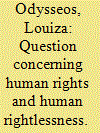| Srl | Item |
| 1 |
ID:
139764


|
|
|
|
|
| Summary/Abstract |
In the midst of concerns about diminishing political support for human rights, individuals and groups across the globe continue to invoke them in their diverse struggles against oppression and injustice. Yet both those concerned with the future of human rights and those who champion rights activism as essential to resistance, assume that human rights – as law, discourse and practices of rights claiming – can ameliorate rightlessness. In questioning this assumption, this article seeks also to reconceptualise rightlessness by engaging with contemporary discussions of disposability and social abandonment in an attempt to be attentive to forms of rightlessness co-emergent with the operations of global capital. Developing a heuristic analytics of rightlessness, it evaluates the relatively recent attempts to mobilise human rights as a frame for analysis and action in the campaigns for justice following the 3 December 1984 gas leak from Union Carbide Corporation’s (UCC) pesticide manufacturing plant in Bhopal, India. Informed by the complex effects of human rights in the amelioration of rightlessness, the article calls for reconstituting human rights as an optics of rightlessness.
|
|
|
|
|
|
|
|
|
|
|
|
|
|
|
|
| 2 |
ID:
124955


|
|
|
|
|
| Publication |
2013.
|
| Summary/Abstract |
In 2008, survivors of the 1984 Bhopal Gas Disaster in India undertook a 500-mile march to New Delhi, protesting a long history of governmental neglect of the survivors of the event. This is one episode of a 25-year-old organized international campaign that continues in the present. This article examines the ways in which three bodily substances - blood, hearts and ketones - were produced and circulated through the 2008 protests. Placed within a broader history of substance-politics in the region, this article suggests that these protests produced an imagination of bodily substances that surfaced messy contradictions that became difficult for the Indian State to disregard. This article also shows how these protests distanced themselves from the cynicism attached to similar modes of corporeal activism in the contemporary Indian landscape. In sum, this article traces the production of an activist corporeal counter-discourse that, for at least a time, contaminated the procedures through which the Indian State disregards the health of its marginal citizens.
|
|
|
|
|
|
|
|
|
|
|
|
|
|
|
|